#freshwater shallows
Text
Bottomless Pits
We post holes here, sir.
Sinkholes, pit caves, wells and cenotes all have one thing in common; sometimes they’re bottomless. Not truly “bottomless”, of course, but in appearance, reputation, or of incredible depth. We’ve seen a few of these “bottomless pits” in prior lists such as the Lost Sea in Tennessee or the Devil’s Hole in Nevada, but today we will focus on those strange places in the earth that seem to be endless.
1. Laguna Kaan Luum, Mexico
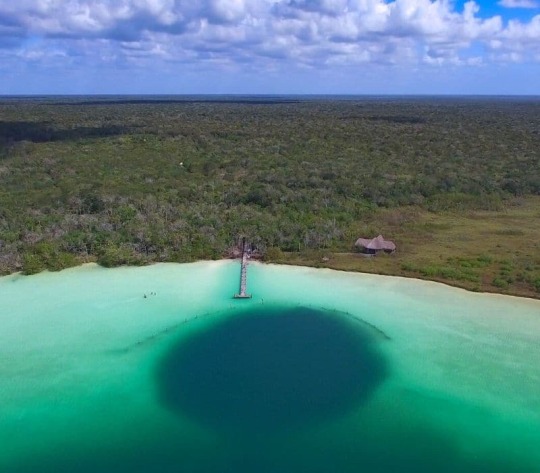
This one threw me for a loop because I was originally only seeing pictures like the one above, so I was like ‘oh, that’s cool, so it’s kinda like Dean’s Blue Hole, where it’s an ocean sinkhole right off the shore…’
No. It’s not that. Let’s zoom out a bit.

Yeah. This is a lake with one giant sinkhole in the middle! It’s about 2,000 feet across and reaches depths of 278 feet, with the surrounding shallows a very pleasant 4 feet deep! I’m mostly including it on the list because the full image hit me like a bus.
2. Sima Humboldt, Venezuela
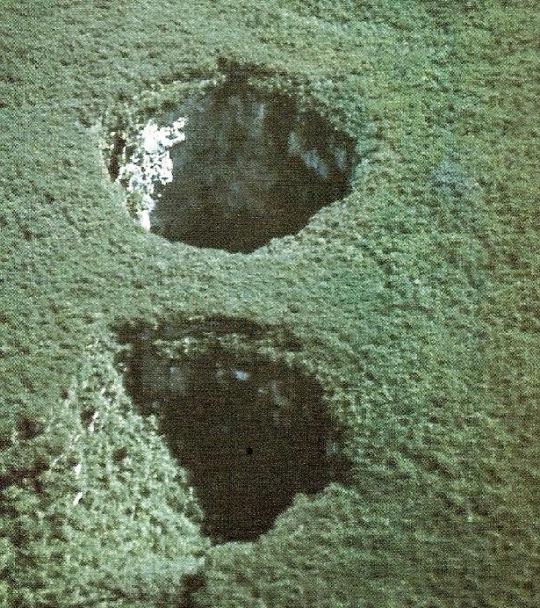
Tepuis are large plateau mountains found across Venezuela, often with sheer sides and inaccessible tops that inspired explorers to imagine dinosaurs still surviving on these isolated mesas. Even on their own, tepuis are incredible, beautiful and mysterious. Add a sinkhole with an even more isolated forest at the bottom, and you have all the ingredients for some crazy shit to happen. Sima Humboldt and Sima Martel are two enormous sinkholes at the top of Cerro Sarisariñama. Humboldt is the largest at over a thousand feet across and nearly the same in depth, with a jungle flourishing at the bottom. The sinkhole forests are home to many endemic species of both plant and animals, but so far, no prehistoric monsters have been found in any of them.
3. Well of Barhout, Yemen
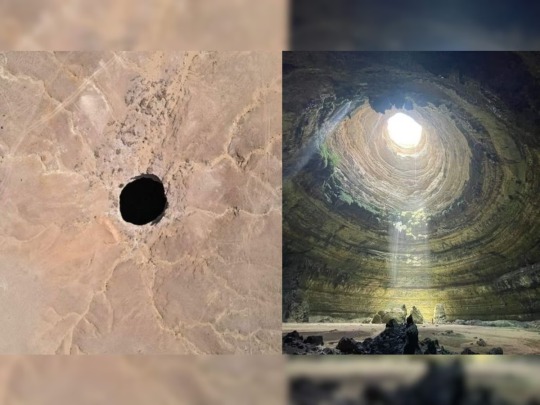
The “well of hell” is a massive sinkhole in the desert, measuring about 100 feet in diameter and plunging down over 300 feet. Understandably, there are many myths and legends about this place, including a story about an evil djinn which lives at the bottom and takes the head of anyone foolish enough to climb in. In fact, so pervasive are these legends that the sinkhole was only formally explored in 2021! Luckily they did not find any evil spirits, but they did find stalagmites which reached 30 feet tall, cave pearls, and waterfalls which provided refuge for frogs and snakes.
4. Myakka sinkhole, Florida
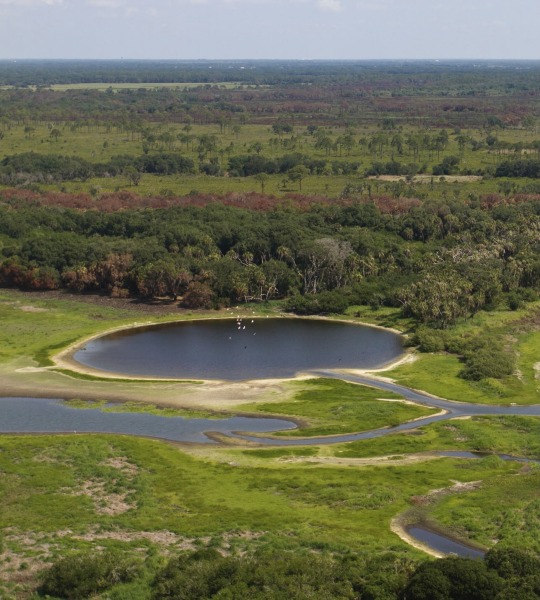
This murky abyss is filled with more than just water, it is also home to over a hundred alligators. Due to the poor visibility and very high concentration of large carnivores, it is very difficult to study this pit. Only a few people have ever glimpsed the bottom of this 134-foot deep sinkhole, but apparently we aren’t missing much because the water down there is stagnant and inhospitable to most life. Exactly why this area is so popular among alligators is still unknown, but it’s likely due to a combination of food availability and ideal temperatures.
5. The Pit cenote, Mexico

Like Cenote Angelita, The Pit is a layered cenote. The first 88 feet is freshwater, then there is a “fog” of hydrogen sulfide, below which lies over 300 feet of brackish water. The Pit is a spectacular-looking cenote, with an almost otherworldly quality, which makes it very popular among divers. So far, this pit has been explored to a depth of 390 feet, but unexplored passages extend further.
6. Thor’s well, Oregon

Like a drainpipe continuously swallowing an unbroken stream of ocean water, Thor’s well is often likened to a bottomless pit. However, it is actually only about 20 feet deep, and the drain effect is due to the fact that it connects back to the ocean, not swallowing the water but simply rerouting it. This does not mean that there is no danger, though. The rocks are slippery and sharp, and this area sees a higher than average number of ‘sneaker waves’; waves that look normal as they roll in but are actually much larger than they appear, potentially sweeping people out to sea as they retreat. The true danger here is the ocean, not the well.
7. Vouliagmeni Lake, Greece
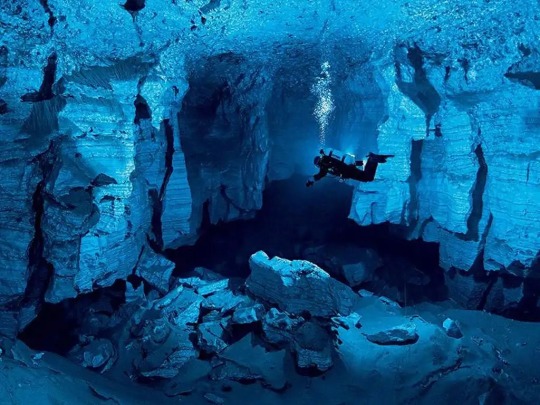
This incredibly beautiful saltwater lake has been rumored to have healing properties for thousands of years, and today continues to draw in visitors for its medicinal minerals and “doctor fish”. But this famous lake hides a secret; a labyrinth of caves whose depths have never been fully explored, and whose connection to the ocean remains undiscovered. Passages stretch over a mile into the mountains, with an average depth of 260 feet. The largest of these caverns is nearly 500 feet wide and full of warm sea water. Although a spectacular diving spot, these unknown caverns are best not underestimated.
8. Santa Rosa blue hole, New Mexico
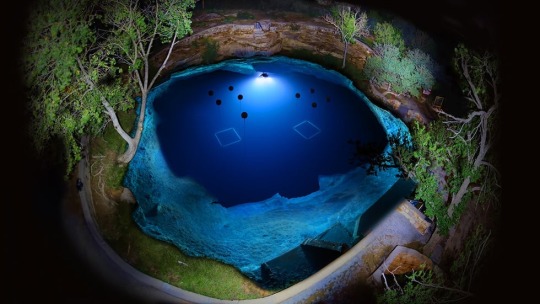
A gorgeous natural swimming hole, this cenote is roughly 80 feet wide and 80 feet deep (in most places) and is a popular destination for tourists. It was also used for diving certification tests, until an incident in 1976. There is one spot in this picturesque cenote that goes down much further than 80 feet; the entrance to a cave. In the dark, twisting passages, two young divers got lost and died, and the cave was later sealed with a metal grate to prevent other divers from attempting to enter. The cave was mostly forgotten about until 2013, when cave divers were given permission to attempt to map the area. The blue hole is at least 200 feet deep, but the bottom of the cave still has not been found.
9. Roaring River Spring, Missouri
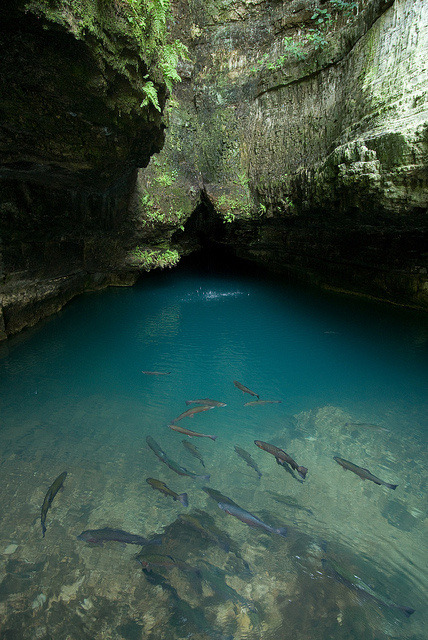
This turquoise river bubbles up from a ten-foot wide pool of deep water hidden within a sheer-sided canyon. But despite its peaceful appearance, this spring discharges 20 million gallons of water a day, and the exact source is still unknown. In 1979, divers attempted to map the cave, but reached a point 225 feet down where the passage constricted and had a water flow like “the force of an open fire hydrant”, preventing them from going any further. In 2020, divers waited until the water flow was lowest in the summer and descended to a depth of 472 feet with no bottom in sight, making this the deepest spring in the US!
10. Your Mom.
I jest, of course. Here’s the real one:
Hranice Abyss, Czech Republic
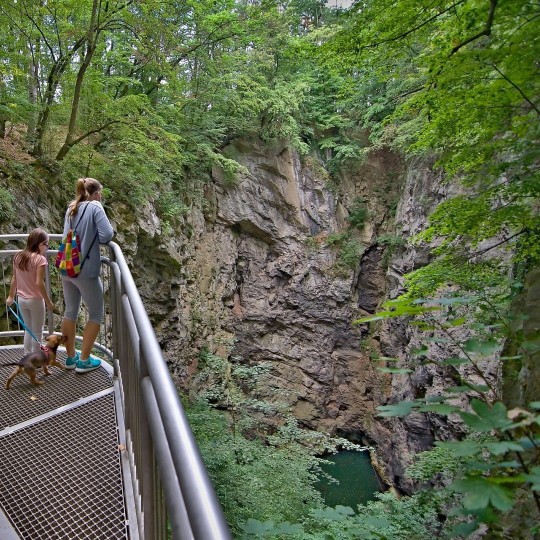
A tiny greenish lake in the forest is the opening to the deepest freshwater cave in the world, deeper than the Empire State Building is high and still seemingly bottomless. It is so deep that scientists think it may have been formed by a totally different process than most freshwater caves; instead of water eroding away the ground from above, it may have been created by acidic groundwater coming up from below. And this water is extremely acidic, able to burn a diver’s skin if not covered properly. This, combined with fallen trees and other debris, poor visibility, and the sheer vertical drop of the cave, creates incredibly dangerous conditions for diving. Because of this, no diver or ROV has reached the bottom yet. But with a recent study using seismic sensors, scientists have estimated that the abyss may be over a kilometer deep, twice what was previously thought.
662 notes
·
View notes
Text

Panacanthocaris ketmenica* here was a member of an extinct group of crustaceans known as kazacharthrans – close relatives of modern tadpole shrimp known mainly from Central Asia during the mid-to-late Triassic (but with possible German relatives from both the late Triassic and further back in the late Paleozoic).
Fossils of Panacanthocaris have been found in Kazakhstan and northwest China, dating to about 235-221 million years ago. It was fairly big compared to most of its modern cousins, reaching at least 10cm in length (~4"), and had distinctive spines around the edges of its carapace and its telson.
It's not clear if it had eyes – there's a single opening near the front of its carapace that may have housed some, and so I've depicted it here with just one naupliar eye similar to the "third eye" of tadpole shrimp.
It probably had a fairly similar lifestyle to its modern relatives, living in shallow freshwater and temporary pools and opportunistically feeding on everything from algae to smaller aquatic animals.
(* Sometimes also called P. ketmenia. May also be the same thing as Iliella spinosa, but until that paper is officially published the current name still stands.)
———
NixIllustration.com | Tumblr | Patreon
#science illustration#paleontology#paleoart#palaeoblr#panacanthocaris#ilellia#ketmeniidae#kazacharthra#branchiopod#crustacean#arthropod#invertebrate#art#triassic weirdos
249 notes
·
View notes
Text
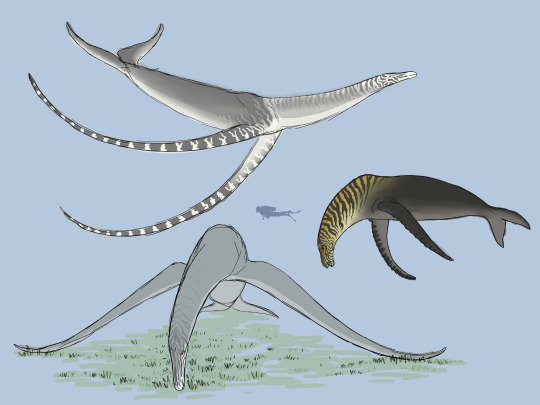
Some sketchy concept stuff that I'm posting because I liked it but couldn't be bothered to refine it into an actual artwork.
These submarine behemoths are the Mermares (Clade Euhippocampiformes), secondarily aquatic descendants of the domestic donkey. The group first appeared around 29 million years post-cataclysm, in the late Nerian stage of the Diluvian period. They evolved from an animal called the Seabra, a descendant of the Donkey which adapted to exploit a niche with, thus far, zero competition - that of a large marine herbivore.
On earth, marine ecosystems are notable for the distinct lack of vascular plant life, a condition caused by a number of factors - most notably the osmotic stress caused by the saltwater. Most photosynthesis is carried out by algae. On Spero, however, things are different. Because Spero's oceans were generated relatively recently, from extraterrestrial ice particles, there just hasn't been enough time for erosion and the water cycle to deposit dissolved minerals in the water. As a result, Spero's seas are made of freshwater - a much more tolerable condition for most plants, and thus the diversity of marine vascular plants is much, much higher than on earth. Also, due to the flatness of the flooded landscape and lack of any real tectonic features, enormous swathes of the seabed lie within the photic zone, less than 200 meters from the surface. Thus, endless expanses of marine grasslands - the "seagrass prairies" - extend from the shore, often for hundreds of miles before the water finally gets too deep for photosynthesis to occur.
All of this plant life is an extremely attractive prospect for herbivores, and it was likely what drew the ancestral Seabra to forage in shallow coastal meadows in the first place. But as the oceans got deeper and life adapted, the Seabra had to adapt in kind - their hind legs rotated backwards to act as a pair of propulsive flukes, their forelimbs developed into steering flippers, and their nostrils retreated to sit on their foreheads.
One notable feature of the Mermares is hyperphalangy, a condition where the fingers have too many bones. It's very common in large marine tetrapods in Earth's history - whales and dolphins, Ichthyosaurs, Plesiosaurs, and Mosasaurs all exhibited hypoerphalangy to some degree - and seems to be associated with the specialization of the limbs into flippers. We would expect to see similar patterns in marine lineages on Spero. What's unique about the Mermares, however, is the sheer number of extra phalanges in the finger; at least fifteen in the shorter-finned species, and more than thirty in the longest-finned forms. And because Mermares - being equids - only possess one digit per limb, the result is a single long chain of flat, squarish bones which, in some cases, can reach over forty feet long - the longest arms ever to exist.
These ridiculous appendages produce a lot of drag and are merely adequate for steering and stabilization. So why do the Mermares have them?
The answer is that they're weapons. And particularly devastating ones, at that.
Mermares use their flagellating flippers as bludgeons, against both predators and conspecifics. The flippers are connected to powerful neck muscles and can be swung forward with impressive force; combined with a well-timed twisting of the giant horse's torso, the huge flippers can impact hard enough to shatter bone and pulverize flesh. The flippers themselves do not escape unscathed, and older individuals often have scarred or mangled flipper-tips from numerous battles over the years; but it's a small price to pay for survival.
When not being used against their enemies, the flippers may be folded back against the sides of the animal to reduce drag, or used as props to keep the animal's belly up off the seabed when feeding. Mermares spend up to 18 hours per day grazing, using their long neck to crop aquatic grasses and other vegetation in a wide arc without moving their bodies and occasionally dipping up to the surface to breathe. Mermares are keystone species in the seagrass prairies; as hindgut fermenters, they are not as efficient at processing plant matter as ruminants like goats, and produce large amounts of nutrient-rich dung which acts as fertilizer for the meadows and helps keep the environment productive. The dung also acts as food for a variety of fish and invertebrates.
Let's look at some of the Mermare's diversity, shall we?
Drepanarion (center right)
One of the smaller Mermares, Drepanarion nonetheless grows to nearly 12 meters (39 feet) long. It is immediately recognizable by the bold black-and-yellow striping on the heads and necks of the stallions, and by the tall, narrow nuchal crest which extends from the withers and makes the stocky body look even more powerful. Unlike most other Mermares, which live in small groups of less than ten individuals, Drepanarion can be found in herds of over a hundred in the seagrass prairies of the Savanian (41 - 50 million years post-cataclysm). These nomadic throngs graze patches of seagrass nearly to the roots before moving on, giving the ecosystem time to regrow before returning in a few years' time. Drepanarion exhibits the most extreme sexual dimorphism of any Mermare, with stallions being both larger and more brightly coloured than mares; during the annual rut, males will fight each other in brutal bludgeoning matches to establish dominance and secure mates. To this end, they have some of the most extreme flipper anatomy of any Mermare; though not especially long (indeed, they have the shortest flippers of any derived genera), each phalanx bone has a protruding bony tubercle on the anterior edge which extends into a keratinous knob. These knobs both protect the flipper during combat and focus the force of the blow into a smaller area, dealing more damage.
Hipposeidon (bottom left)
First appearing in the early Imberian (50 million years post-cataclysm), Hipposeidon is the largest of all Mermares and, indeed, the largest animal ever to exist on Spero, with stallions regularly reaching over 24 meters (80 feet) long (mares are slightly smaller). Extremely large specimens may even reach 30 meters (100 feet), although this is rare. This ludicrous size - nearly rivaling even the mighty Blue Whale of Earth - is possible only due to the sheer abundance of its food. Hipposeidon appears at the height of the seagrass prairie's extent, and can pack away almost 900 kilograms (1900 pounds) of seagrass per day. This superlative food requirement has important consequences for Hipposeidon's behaviour; this animal is migratory. Seagrass prairies are extremely productive ecosystems, but nonetheless Spero is a seasonal world; as the summer growth gives way to the winter die-back, the greatest of the Mermares must migrate across the equator to seek out a continuous food source to fuel its immense bulk. In this way Hipposeidon experiences a perpetual summer, interrupted only by the biannual migration from north to south and back again. Female Hipposeidon are pregnant for about one year, timing the birth of the single large foal with arrival to the feeding grounds; the six-meter-long foal enjoys a long childhood nursing and playing in shallow summer waters, gathering strength before making the long swim across the barren tropical zone to pastures new.
Bathypegasus (top left)
The last and possibly the weirdest of the great Mermares, Bathypegasus is the only member of the clade which is not a grazer. Instead, it is a specialist feeder on pelagic, free-floating ferns. These ferns are a seasonal bounty, growing in huge numbers in the tropical summers of the late Imberian (60 million years post-cataclysm), where the planetary ring system shades out large portions of the planet for half the year. A close relative of Hipposeidon, Bathypegasus has left its ties to the seabed behind, becoming a fast, powerful swimmer which spends most of its life far above the sea floor. Its flippers have adapted to be even more ludicrously long - the longest forearms of any animal, ever, with each one measuring nearly 14 meters (45 feet) in length and each containing at least 35 individual bones. No longer used to prop the animal up off the seabed, these whiplike flippers are narrow and streamlined and can be whipped through the water at speeds of nearly 20 meters per second (that's over 40 mph) - the most extreme weaponry of any Mermare, and used to great effect against predators. Bathypegasus, like Hipposeidon, is migratory, following the blooms of pelagic ferns across Spero's oceans. Thanks to this midwater diet it is the only genus of Mermare to survive past the mid-Imberian extinction, when rising sea levels and steepening coastal slopes caused the seagrass prairies to disappear. Bathypegasus finally died out in the Ultimoxerian stage, around 75 million years post-cataclysm, the last and weirdest of the giant marine horses.
#spec bio#spec evo#speculative biology#speculative evolution#Vicis Aeternum#Spero#seed world#equid#donkey#they're like if a whale and a horse had a baby and that baby was somehow also a diplodocus
848 notes
·
View notes
Text
Slymphs are aquatic parasites commonly found in brackish water, such as estuaries and coastal swampland, though certain species of freshwater slymph may be found inhabiting the shallow regions of lakes and slow-moving streams. They typically range in size from a few inches to roughly a foot long, with the largest specimen on record measuring just over three feet.
Slymphs feed via the suckers on either end of their body, marked by two or three concentric rings of teeth. Once a slymph latches on to a host, it injects a cocktail of neurotransmitters that serves to convince the host's nervous system that the slymph is a perfectly healthy part of their body. The host will subsequently react negatively to any attempt to remove the slymph, with similar intensity to the proposed amputation of an arm or a leg.
If the slymph is killed or otherwise removed, the conviction that it is part of their body will remain, and the host may seek medical attention for the detached slymph, or try to reattach it themselves. This delusion will fade over the next day or so as the slymph's saliva is flushed out of their system.
If, however, the slymph is allowed to remain attached, it will gradually integrate its circulatory system with the host's over the course of several months, its mouthpiece dissolving to meld with the host's flesh. This new appendage seems to have little deleterious effect on the host, other than potentially being cumbersome or unsightly, in addition to the periodic urge to go wading in brackish water in co-incidence with slymph mating season. Those possessing this organ treat it like any other part of their body and attribute to it a panoply of useful functions, such as helping to filter the toxins out of their blood, or making them more sensitive to moisture in the air. So far, any such effects have yet to be empirically proven.
A similar adaptation can be observed in the so-called "emperor slymph", which despite being closely related to the slymph is a different species altogether. The emperor is known by a number of regional names, some of the more colorful ones including: the brackwife, godsflesh, Tom's Lost Scrote, the crown-of-limbs, and twinning folly. The emperor slymph will ambush its prey using its multiple proboscises, which it can fling out like harpoons to inject its prey with a potent dose of neurotransmitters in order to pacify them. Unlike its smaller cousin, the emperor slymph will only feed until satiated, unlatching after it has had its fill of blood.
A person who has served as nourishment for an emperor is under no delusions about its physical characteristics. They will be perfectly capable of recognizing it as a multi-headed beast about the size of a walrus, with snaking necks and sucking toothless mouths designed to seal around a wound, sluggish and territorial, spending hours submerged beneath the water waiting for unsuspecting prey to come wading through its swamp. They will simply be convinced that this bloated creature is somehow a part of their own body, its hungers as natural as their own stomach grumbling at them, and must be provided for and taken care of as such.
Those afflicted by an emperor slymph will return to it for regular feedings. If the emperor has been hunting poorly, and they are its only source of blood, they will take their own anemia as a sign that the equivalent of a blood transfusion is necessary to stay alive. How they go about acquiring someone else for the emperor to feed on will vary greatly from person to person, depending on the severity of their situation and the morality of the person involved.
Multiple cults and communes have grown around the appetites of an emperor slymph, as a surplus of people to feed on means the quantity of blood drawn from each is reduced to a mere tongueful, almost ceremonial. Some adherents of this faith will claim that their mutual feeding has created a bond closer than love or kinship. As their philosophers and theologians propose, not entirely without merit: the slymphs' compatibility with our biology suggests a shared design that runs through our disparate natures, as if all the strange and wondrous creatures of the earth are more fundamentally the same than we realize, each of us an outstretched limb of divinity, flesh of flesh and blood of blood.
314 notes
·
View notes
Text
Phylum Round 1

Onychophora: Velvet Worms. This is the only phylum containing exclusively terrestrial members, although their ancestors can be traced back to the Cambrian shallow oceans. Onychophorans are ambush predators, moving with slow smooth steps to creep up on their prey. They have unique mucus glands on either side of their face which can spray jets of sticky slime, which effectively immobilizes their prey. Onychophorans have relatively complex brains, and some even live in social "packs" that live and hunt together. Many species in this phylum are ecologically vulnerable, threatened, or endangered.
Platyhelminthes: Flatworms. This phylum includes both colorful free-living members and more modest parasitic members. Free-living worms can be found in marine, freshwater, and even terrestrial environments. All flatworms are, of course, dorsoventrally flattened so their whole bodies can access oxygen from the outside, as they have no specialized circulatory system. Some flatworms are of interest to research in tissue regeneration, as they have the remarkable ability to completely regenerate a new body from a cut piece. Many classes within Platyhelminthes are exclusively parasitic, including flukes, tapeworms, schistosomes, and others. Most flatworms are hermaphroditic, and some larger marine species practice a ritual known as "penis fencing" to determine which worm's eggs will be fertilized.
#worm on worm violence#the wikipedia article on onychophora is unusually detailed and thorough which is delightful#cw parasites#onychophora#platyhelminthes#animal bracket#tumblr bracket#bracket tournament#poll bracket#phylum round 1#phylum
274 notes
·
View notes
Text
"Spitting Out Water Babies"
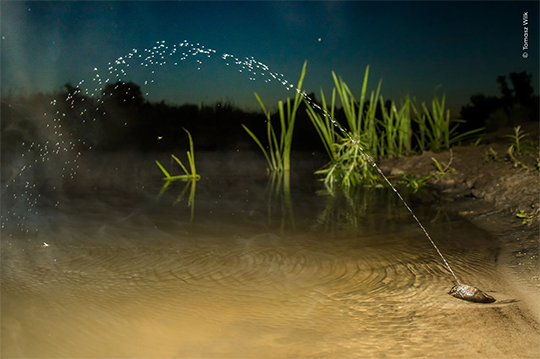
When Tomasz Wilk settled to camp one evening on the banks of a Polish river, he didn't expect to find fountains in the shallows. Though reminiscent of an archer fish's shot, this stream comes from a freshwater mussel. (Image credit: T Wilk; via Wildlife POTY)
Read the full article
90 notes
·
View notes
Text
Wet Beast Wednesday: lampreys
Welcome to the first Wet Beast Wednesday covering an agnathan. What is that, you may ask? Why it means jawless fish. But they aren't really fish even though they live underwater and have gills. Taxonomy strikes again. Anyway, agnathans are more closely related to each other than to any bony or cartilaginous fish and they may represent an early stage in the evolution of vertebrates. There are only two living groups of agnathans: the hagfish (which I'll get to sometime) and the lampreys.

(Image: a pair of lampreys, one resting on rocky sediment and one swimming. They are long, green, slender fish-like animals with only dorsal and tail fins, several holes on the sides of the heads, large eyes, and no visible jaws. End ID)
Lampreys are sometimes mistakenly called eels due to their long and slender bodies. All 38 known species are elongated, scaleless animals with a funnel-shaped, jawless mouth called the buccal tunnel or buccal cavity. They do not have paired fins, only two dorsal fins and a tail fin. The head has one nostril on the top and seven pores on each side that allow water flowing over the gills to exit the body, similar to the gill slits of sharks. Adult lampreys have well-developed eyes while the larvae have weak eyes covered with skin. In addition, they have two simple parietal eyes, making lampreys the only four-eyes vertebrates. The mouth acts like a suction cup and is used to suction onto rocks or other animals. Inside the mouth is a rasping tongue that is used to scrape at food. You may think that all lampreys are parasites that feed on blood. This isn't the case, only 18 species are predatory and some of those are thought to be exclusively scavengers. The rest of the species either feed on algae by scraping it from rocks or never eat as adults, subsisting entirely on energy stores gained as a larva. The last common ancestor of all living lampreys (which is estimated to have either lived during the Jurassic or Cretaceous periods) is believed to have fed on blood as an adult. Lampreys are believed to be part of a sister group to all jawed vertebrates and are considered the most basal (closest to the ancestral form) of all vertebrates. They have cartilaginous skeletons and primitive, cartilaginous structures called arcualia instead of vertebrae. Lampreys are some of the most efficient swimmers and swim using a different method to other fish. Instead of using their fins to push themselves forward, lampreys use their fins to generate low-pressure zones in the water around their bodies to pull themselves forward. The pressure equalizing is what does most of the work of moving the lamprey, allowing them to move while expending little energy. In shallow water, the lampreys can use their suctioning abilities to crawl forward and are able to crawl over obstacles like rocks or ramps. Most lampreys are exclusively freshwater dwellers, but 9 species (all of which are carnivorous) live mostly in saltwater (though they can also live in large bodies of freshwater like lakes) and return to freshwater to breed. Of the 38 species of lamprey, only 5 species (in two families) live in the southern hemisphere. The remaining species are all members of the family Petromyzontidae and live in the northern hemisphere. No species lives in the tropics, seemingly because their larvae are not heat-tolerant.

(Image: a lamprey's mouth seen from below. It round and conical and ringed with multiple rows of sharp, yellow teeth. End ID)
The lamprey life cycle of lampreys starts in streams which adults will often migrate to reach. Adults will create nests called redds by using their suction to move rocks and expose the sediment below. Males use pheromones to attract females and the two intertwine with each other. The male presses a patch of heat-producing tissue to stimulate the female to release her eggs. The male fertilizes the eggs as they emerge. All lamprey species are semelparous, meaning they die after mating. In the case of lampreys that don't eat as adults, their adult forms exist only to mate and die, much like mayflies and some species of moth. Other species that can eat as adults spend up to 4 years feeding and growing before they mate. Larvae are called ammocoetes and once hatched, they are carried downstream to eventually settle on soft sediment. There, they burrow their rear halves into the sediment with their heads exposed. In this stage, they are filter feeders who need running water to bring plankton, algae, and bits of organic detritus to their mouths. Instead of the disc-like mouths of adult lampreys, ammocoete mouths are fleshy hood that enclose a sieve-like structures that filters particles out of the water. The lifestyle of ammocoetes is very similar to that of lancelets, which are extremely primitive chordates believed to represent some of the earliest stages of chordate evolution. Ammocoetes require water high in nutrients to survive as they capture only a small amount of water and therefore food. Ammocoetes are photosensitive, allowing them to change color in response to ambient light (becoming dark in the day and ale at night) and detect if they are properly buried. Depending on species, ammocoetes can grow between 10 and 20 cm (4-8 in) in length and they can spend between 1 and 10 years in this state. Metamorphosis to the adult form can last up to 4 months and lampreys do not feed during this process. Metamorphosis is synchronized between members of the same species.

(Image: three ammocoetes buried in sand with only their heads exposed. They are similar to the adults but pink, with small, barely-visible eyes, and their mouth are flexible and look like fleshy flaps. End ID)
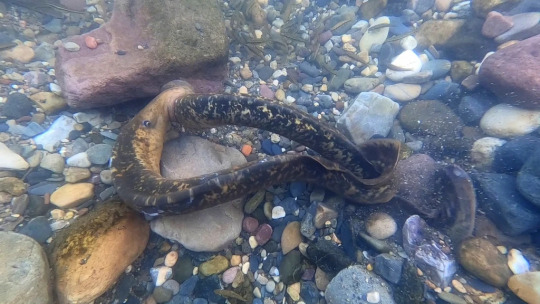
(Image: two lampreys mating. they are coiled onto each other with one using its mouth to suction onto the midsection of the other. They are on a rocky stream bed. End ID)
Lampreys are used in science for several purposes. They are often used as a model organism when attempting to understand the biology of early vertebrates and extinct agnathans. They are also studied quite a bit for their nervous systems. Lamprey brains are very simple and likely represent very early stages of brain development in vertebrates. In addition, they are useful for studies of the transmission of electrical impulses between nerve cells due to their axons (the part of a nerve cell that conducts electricity away from the main body and to other nerve cells), which are large enough for microinjectors to inject test substances into them. Lampreys are capable of fully recovering from having their spinal cords severed, something that is of great interest to surgeons and neurologists. Lampreys have been used as a food source in many cultures around the world. Some species have toxic mucus and blood, requiring them to be cleaned before eating. Historically lampreys have been kept in captivity for use in food as well as other purposes. There are records of people being executed or tortured by being thrown into a pit of carnivorous lampreys. In the wld, carnivorous lampreys generally don't attack humans unless they are starving. In addition, there is a record of one Roman statesman named Lucius Licinius Crassus being scolded for being more upset over the death of his pet lamprey than over the deaths of any of his wives. Unfortunately, the thing a lot of people know lampreys for today is the sea lamprey (Petromyzon marinus) being an invasive species in the great lakes of North America. They have no natural predators in the lakes and feed on a lot of ecologically and commercially important species. Due to their lack of predators, multiple methods are used to try to reduce their numbers and keep them from harming the ecosystem. These include using barriers to keep the adults from migrating upstream to breed, release of targeted poisons called lampricides, and releasing sterilized males into the lakes to mate with the females.

(Image: two sea lampreys suctioned onto a fish. The fish is green and covered with black dots. The two lampreys are suctioned next to each other on the top of the fish's head. Their bodies are dangling off of the fish in different directions. End ID)
#wet beast wednesday#lamprey#sea lamprey#agnatha#agnathan#jawless fish#fish#fishblr#marine biology#freshwater biology#ecology#zoology#animal facts#informative#image described
79 notes
·
View notes
Text
I pulled this book for a project at work and never have I jumped on the Abebooks website so fast to see if there was another copy of a book for sale as I did after I flipped through it.
I have been keeping aquariums for 30 years now, and this will be a great addition to my personal collection of Books About Fish!
“Shallows of the Sea” was printed by Lamar College’s “Blotter Press” in 1966. It contains many lovely silkscreened images of freshwater fish (including many species familiar to the aquarium trade).
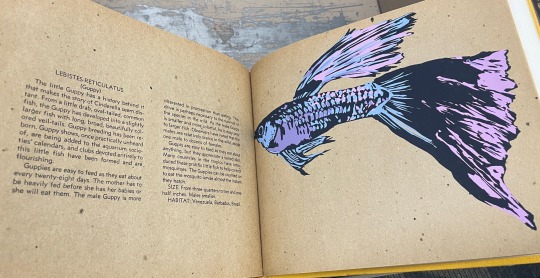



I can’t wait for my copy to arrive in the mail!
#original content#fish#aquariums#screen printing#fine printing#small press#books#art#aquarium#book collecting
261 notes
·
View notes
Text
i think it starts with an apocalypse. by sheer luck and circumstance, you survive. you seem to be the only one.
everything seems barren, eerily still, nothing but grass and trees and water. you survive, but there is nothing here. the only sign that anyone was ever here is pyramids of solid red brick, stacked up in a uniformly triangular shape. they don’t seem to do anything. you are alone.
your first night finds you tormented by the dead. they groan and creak and seem to be desperate to infect you. they are all dead by morning.
there’s only a few resilient species that seem to have survived along with you. they’re your only chance right now. the sheep provide companionship. you learn not to get attached to the pigs.
you build a home for yourself. it’s modest, nothing fancy, but it protects you from the elements. you still have hope. your footsteps echo through the empty house in the mornings. you are alone.
it takes years, but ever so slowly, the second hominid re-emerges. they build villages and farmland and are happy to barter with you. they have their own language. you seem to have forgotten yours.
you find the remains of wild animals you haven’t killed. you learn to be patient, and watchful, and you see the wolves that hunt in the forests. it takes a long time, but you gain the trust of one of them. she never leaves your side again.
you explore a little more. you find ancient temples in the deserts, booby trapped and filled with forgotten riches from millennia ago. you don’t know who built this. whoever it was disappeared a long time ago.
jungles flourish and bring with them tropical fruit and colourful birds and skittish cats that seem to love fish. you take home as many as will follow you. the world isn’t quite so quiet anymore.
the oceans come alive again. it’s no longer an empty, unforgiving void that you just so happen to be lucky enough to float on. schools of fish flicker away into vast kelp forests when you cast your lure into the water. the tropical shallows fill with a myriad of fish and coral in every colour you can think of. you find an old boat, much bigger than anything you could ever construct, laying dormant at the bottom of the sea. the writing on the maps you find there is familiar.
there is a temple in the middle of the ocean. you don’t know who built it, but it’s been reclaimed by the fish. you don’t dare go there anymore.
bees buzz softly through the air. you learn to keep them, and learn to harvest their honey, and your crops grow better than they ever have. your livestock keep you busy. your livestock keep you distracted.
even the lost dimension that connection to was severed so long ago returns to its former glory. you explore forests of mycelium and dunes of sticky sand and basalt spires and with them they bring the lost intelligent hominid. you learn quickly not to touch their temples, no matter how run down they seem to be. they are holy.
and even in the most hostile, barren places, deep underground, the place where only you seem to have ever been, life flourishes. glowing lichen lights your way and bears you fruit. massive caverns and underground freshwater pools are home to unique plants and unseen amphibians.
and even after so much growth, and so much recovery, you are still alone.
you search. you search for months that turn into years that turn into decades. what was once a humble homestead has grown into a fortress. you are safe there. you are alone. on every expedition, you leave markers and statues, anything to say i was here. i am alive. you set up beacons to signal to anyone who might be out there. no one ever responds. you are alone.
you follow forgotten maps to the ends of the earth to find anyone that might have survived alongside you. you cannot give up. you cannot be alone.
you experiment. you’ve found a way to cure infected villagers, to return them home, but have had no such luck with the remains of your own species. you think they’re your own species. they’re the closest thing to you that you’ve seen. you grow desperate.
the humanoids that walk freely between their realm and yours used to frighten you, but you’ve been alone for so long you find yourself talking back to them. you begin to hear greetings in the noises they make. you know they aren’t talking to you. you wish you could talk to them. you don’t try to make eye contact.
you follow every clue you find in forgotten ruins. they always lead to nowhere. you piece together portals to other worlds, and find nothing but hostile hellscapes and misery. you have travelled across the world. you’ve gone from blistering deserts and over unforgiving mountains and through freezing tundras and across oceans to find someone, anyone. there is never a new signal, a new clue. there is never anything to indicate that there are any survivors.
you are alone.
your bones creak. it’s been so long. you don’t want to die. you don’t want to take your species with you.
so what do you think, when you turn to see someone standing in a doorway in your fortress that you spent decades building? someone so unmistakably human, someone you’ve spent your entire life searching for to no avail, someone you’ve been constantly lying to yourself about, convincing yourself they were out there somewhere, all the while knowing they weren’t?
you don’t know if you’re hallucinating, if you’ve finally slipped into madness. if this is just a stroke of bizarre luck, that the other survivor has found you before you could find them. if this is another malevolent entity in a world full of strange magic and power, something that was once human, or is only somewhat, or is just appearing to be, and is simply better than the others at pretending.
only one way to find out.
#i think today i will write a poem about minecraft#mc is a psychological horror game. and i fully believe this#and that makes it one of the best games ever made amen#btw dsmp fans dont interact. i hate you and your racist white guys#rambles#poetry#poems#minecraft#mc#horror#writing#my art#long post#psychological horror#unreality#100#best
2K notes
·
View notes
Text

a tall, tall tale no one believes
Fandom: Percy Jackson and the Olympians
Pairing: Sally/Poseidon
Rating: M
Word Count: 875
Summary:
How do I feel? she asked, and he told her, weak in all his strength, Wet.
Sally can’t sink, which is a strange trade-off for raising her little boy alone, but it’s just a fact of her life. The ocean bears her up. At the cottage, she rinses vegetables in a colander in the sink and, if her hands dip in to agitate some brussels sprouts, the water floats them to the top, refusing to sieve through the holes, refusing physics, cradling the back of her hands. Her fingertips never prune.
It’s the same in her apartment’s bathtub, the Finger Lakes, the model boat pond in Central Park. Percy isn’t sure about it, only four, but she helps him set his boat on the still water. The moment Sally slips her hand beneath the surface, a current propels the boat along. Her son is surprised and delighted. She wonders whether Poseidon can see, whether the water is a two-way glass, whether he feels any paternal instincts that aren’t too supernatural to put in a parenting book. Regardless, it makes her smile to watch them playing together at the park, the sunshine on Percy’s hair.
She teaches him about it: how wild water and domestic water touch. About rain and rivers, aquifers and Arctic thaw, treatment plants and tap water. How it’s all connected, like her and him. She rubs her thumb across his freckled cheek. All one thing that will always find its way back to each other, to the ocean. Those concepts are so bound up, but Sally doesn’t tell him, not yet. Instead, she laughs when Percy puts his ear to the closed tap and claims he can hear the ocean. Sally, unsinkable, would believe him in a heartbeat, except that he’s giggling the whole time. She tells him, Well, it’s time for bed. Try not to get any perch caught in your toothbrush. He’s at an age now where his end of their make-believe will drop away unexpectedly. Those are freshwater fish, Percy corrects. Her mistake.
Older, and he’s at school. The bathroom is unbeatable for oasis per square foot; it’s where she goes when the apartment is loud, or quiet, or it’s pouring and she’s in a mood that makes her afraid of what the people in the building across from hers will think if she climbs out onto the fire escape and gets too friendly with the rain. In the shower, where the water came from the ocean, sometime, someway, somehow, Sally makes it cry down her body before it returns to his domain. Remember me? is the question she doesn’t speak aloud. Her boyfriend keeps complaining to the super that the pressure’s for shit, that the spray is cloudy, that he gets out of the shower grimier than when he got in. But water pours clear as glass from the head and runs over Sally’s closed eyelids, her parted lips. It’s her lover on her skin, and sometimes she feels crazy for thinking it, but then the water streams along the blue veins visible on the pale parts of her breasts that were (usually) covered during their long summer at the beach, and traces the grooves of stretchmarks in her stomach and thighs, and she’s sure that he’s tracing her, her lines that wind like rivers, her body of water.
She remembers being pregnant with Percy. Back to the cottage, the shoreline in the fog, her hands in the kitchen sink. Oh, she would wade into the shallow water and ache for Poseidon. Her clothes discarded on the sand, Sally would hold her buoyant belly and understand what it felt like to be bigger than the skin that held her. Was that how he felt, when he was there? The size and shape of a man, but so much more? And less? Contained in one form, and then—she would stroke the place where Percy kicked—another.
She remembers before she got pregnant. How do I feel? she asked, and he told her, weak in all his strength, Wet.
Fire and water don’t go together, and that seems cruel, because she’s always sitting in the rain when she misses him most. Matches often won’t stay lit long enough for her to touch them to an offering. Tic Tacs from her purse stick together in her palm as their coating dissolves. A partially eaten granola bar Percy left in her coat pocket goes soggy as its silvery wrapper fizzles away from the weak flame. Cruelest, the toast she burnt by accident in the toaster refuses to catch as she dances fire along the crust on purpose. Some days, it’s more than she feels able to bear.
When she wants to, Sally can dive deep. Down there, it feels like she’s holding her breath longer than most people—most humans—can. It could just be her imagination. She’s not a god.
Water, for her, will never wash things away. It’s a tide, seemingly made up of equal comings and goings at first, but drawing everything in eventually. Her floating is an uninsurable chronic condition. Sally isn’t complaining, she just has to wonder sometimes. About fate. About the urge she has to cup her hands at the mouth of a downspout and splash her face with the draining water. To make him touch her as he passes through.
#my writing#Percy Jackson and the Olympians#PJatO#Sally Jackson#Poseidon#Percy Jackson#Sally x Poseidon#Percy Jackson fic#PJO fic
83 notes
·
View notes
Photo

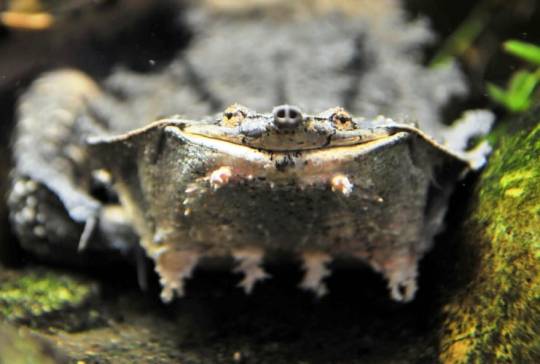
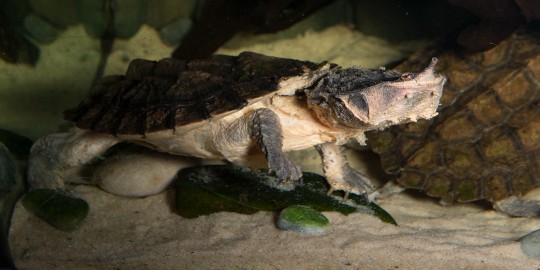
A Mata-Fine Mata Mata turtle
A resident of the Amazon and Orinoco river basins, the mata mata (Chelus fimbriatus) is a species of freshwater turtle found in streams, pools, and wetlands throughout northern South America, from Venezuela to Brazil, as well as the island of Trinidad. This species is almost entirely aquatic, and excursions on land are extremely rare. However, they are not well adapted for swimming in open water, and are thus most commonly seen in shallow bodies of water with soft, muddy bottoms.
C. fimbriatus has a unique appearance among turtle species. The carapace-- the part of the shell that covers the back--it has three ridges running down its length and is often covered in algae, and so resembles tree bark. The head is similarly shaped to resemble leaf litter; it’s triangular, and the fringes around the cheeks and mouth break up the outline. The mata mata’s nose is long and snorkel-like, allowing it to remain just under the surface. Despite its unobtrusive looks, this species is actually quite large; mata mata can grow up to 45 cm (1.5 ft) long and weigh up to 17.2 kg (38 lbs).
Because of its unique body shape and camouflage, the mata mata is well suited to a sedentary life, and has few natural predators. It has extremely poor eyesight, though it does share an adaptation with other nocturnal reptiles that allows the eyes to reflect low levels of light. To compensate, the mata mata relies on its hearing, amplified by a large tympanium on either side of the head, and on the barbels lining its jaw. In addition to being an excellent costume, these barbels allow C. fimbriatus to sense vibrations in the water. The mata mata spends most of its time submurged or buried under the mud, waiting for potential prey like fish, worms, crustaceans, and insects to swim by. When they’re close enough, the mata mata opens its jaws and sucks its target in whole. Individuals have also been recorded herding schools of fish into confined areas before feeding.
The only time the mata mata emerges from the water is to reproduce. Individuals are solitary until September or October, when they begin to seek out mates. When a male encounters a female, he approaches while opening and closing his mouth, extending his limbs, and moving the flaps on the side of his head. If the female is impressed, she allows him to mount. Afterwards, she hauls herself out onto the nearby bank and builds a rudimentary nest from the forest litter. There, she lays 12-28 eggs, which will take about 200 days to hatch. There is no information on how long hatchlings take to fully mature, but individuals can live anywhere from 15-30 years.
Conservation status: The mata mata has not been evaluated by the IUCN, but is threatened by habitat destruction and overharvesting for the pet trade.
If you like what I do, consider leaving a tip or buying me a ko-fi!
Photos
Rune Midtgaard
Christopher Wellner
Joachim S. Muller
#mata mata#Testudines#Chelidae#Austro-South American side-neck turtles#side-neck turtles#turtles#reptiles#freshwater fauna#freshwater reptiles#rivers#river reptiles#wetlands#wetland reptiles#south america#Northern South America#Amazon Rainforest#animal facts#biology#zoology
234 notes
·
View notes
Text
𝐌𝚶𝐌𝚬𝐍𝐓𝐒 𝐈𝐍 𝐓𝐇𝚬 𝐒𝐏𝐑𝐈𝐍𝐆
tags: wc: 972, 18+ dni, established relationship, reader is on top, dan heng is a virgin, handjob, skinny dipping, mention of blood reader is a slight masochist, sex in a freshwater spring, in his dragon form + has a tail for @itoshisoup love u very much miss mao.
synopsis: here in the spring dan heng loves you most.

The water of the spring was not like the saltwater of his home - it was sweet and slid down his throat as easily as his breath did. When you kiss him, he can taste every note of the spring water that clings to the skin of your lips. Kissing you always felt like a ship through the air, as easygoing as one's heartbeat but it’s different now; here alone and naked in this spring on the planet you took him too as a surprise. Dan Heng shivers and can’t help but moan, he was so sure he knew what silk felt like but not even the finest of the material compares to the drag of your tongue against his. You pull back with a grin and he knows that the pink on his face can be seen by the moon as he reads the smugness in your lips.
“Make that sound for me again Heng’er,” Your words are like the notes of the flute gentle and high into his ears that make his azure blue tail sway in the water where your naked bodies are submerged in. Your hand is soft against his skin and his face grows more warm with how easily your limb fits against the flesh of his thigh. Dan Heng never was the largest of men but when he sees how easily you fit into his form some sort of heat dances along his spine, blistering lust so different to the cool existence the Vidyadhara live he almost doesn’t know what to do with himself. Which is why it is easy for you to take his cock in your hand, his almost purple head peeking from the shallow water you two reside in. The slight glide of your thumb against his head makes another moan tumble out from his chest, pink from the tips of his ears to the center of his chest as the sound of his tail splashing behind you is followed by another laugh.
“Heng’er - are you so easy to please?” You are teasing him again, and you are fairing no better. The pleasant spring is freezing against the lust that burns in your stomach at the sight of the man you love beneath you. Dan Heng was handsome, but in more recent times you can’t help but find him beautiful. A water lily of your own, one you can’t help but cradle in your hand and worship lovingly with the swipes of your fingers. Dan Heng is quick to shake his head; a denial of the truth because when it comes to you - the way your lips shine from the dew in the moonlight and even the strand of his plastered across your face from when you dove right into the water.
Dan Heng will always be pleased and spoiled by the likes of you even when this life cycle ends he will be haunted by the silk of your tongue and the softness of your hands.
“Yes - yes, always if it’s you.” His words tumble out his mouth like rainfall and your hand had gone from teasing him to pumping his length with twisting motions. His veins are worshiped by the lines of your palm, matching and following all of your love lines until his own hands come to gripe at your hips. He hears you hiss at the sting of his claws as they follow the curve of your hips to where your ass begins.
“Yeah? That so Heng’re?” You ask, voice breathless at the admittance and high off the way Dan Heng becomes a sight of wonder when bathed in his lust. His cock is slick, and his usual cool skin burns in your palm, you feel him twitch and your grin grows in time with the volume of his moans. Something can be said about how your eyes turn feline at the last defeated sound Dan Heng, mighty in all other roles but helpless beneath you, makes as his own hand gripes at you like you’d fade away with the pleasure you give onto him. You bite your lip to quiet the soft sound of pleasure that nips at your spine from the delightful sting of the thin scratches that run thin rivers of blood. Dan Heng comes with a shout, the loudest you’ve heard from him yet and you moan in time at the sight of his fang glinting with his own drool as he pants desperately. You coo, your own eyes flickering between his beautiful pleasure-stricken face and watching more strings of his cum dribble out and spill over your knuckles. You open your mouth to tease but you don’t even get your pet name for him out before his elegant hand finds itself on your head to bring you down into a kiss.
It isn’t elegant, your teeth knock into each other and your tongue is bitten by a stray fang but you moan into it all the same because it is Dan Heng and everything he gives you is perfect. You pull apart with strings of drool sticking between you two and smile at him, truthfully and lovingly - Dan Heng is struck by how beautiful you are all over again. In between pecks, you ask if he wants more, the “real deal” as you call it but he refuses with blushing cheeks and timid eyes.
“I want to have all of you in a more special time, something you deserve.”
He utters, blue eyes watching the small ripples in the water as you smile lovestruck at his admission. Your arms go around him, his face goes to his chest and turns as red as the liner on his eyes when you squeal, “Gege! You’re so romantic!” But still, he smiles in your embrace, as happy as he can be here in the moment in the spring.

129 notes
·
View notes
Text

Ellimmichthyiformes were a group of ray-finned fish known from the early Cretaceous to the mid-Oligocene, about 140-30 million years ago. For much of that time they were quite widespread, found in various marine, estuarine, and freshwater environments across Africa, Eurasia, and the Americas.
Closely related to modern clupeiformes (herrings, sardines, and anchovies), and characterized by two rows of bony scutes – one in front of the dorsal fin and the other along the belly – they're also known by the nickname "double‐armored herrings".
Rhombichthys intoccabilis was a rather unusual-looking ellimmichthyiform from the mid-Cretaceous, around 95 million years ago. Living in shallow reef and lagoon waters covering what is now the West Bank in the Middle East, it was about 20cm long (~8") and had a tall narrow dorsal fin along with incredibly elongated belly scutes that gave its body a rhombus-like profile.
Juveniles of this species seem to have lacked the extended belly scutes, instead having a much more rounded body shape. This may indicate that adults and juveniles occupied very different ecological roles, or that the distinctive scutes might have been a secondary sexual characteristic involved in displaying for courtship and reproduction.
———
NixIllustration.com | Tumblr | Twitter | Patreon
#science illustration#paleontology#paleoart#palaeoblr#rhombichthys#paraclupeidae#ellimmichthyiformes#double-armored herring#actinopterygii#fish#art#what are you even doing rhombichthys
765 notes
·
View notes
Note
Broke: forbidden romance between a human and a merfolk
Woke: forbidden romance between a saltwater merfolk and a freshwater merfolk
Bespoke: forbidden romance between a deep-sea merfolk and a surface-dwelling merfolk who are kept apart by the differing water pressure that's harmful to either of them
I think they're all good tropes though
*whispers and points to this story in case you or someone else missed it*
Deep sea merman x shallow-water merman (Oneir x Ilarr) Part One and Part Two
64 notes
·
View notes
Note
Hi I found some freshwater amphipods in a shallow stream in Pennsylvania and I want to know if they will survive being kept in a jar with some rocks, silt, and leaves from the area they were taken.
stream stuff I’d imagine would need more aeration and moving water than a stagnant jar would provide, but I don’t do aquatics
40 notes
·
View notes
Text

A map of the clans’s territories marking significant locations.
Location descriptions under cut:
1. The Moon Glacier
Said to be a piece of the moon itself, fallen from the sky onto the earth below. This massive chunk of ice slowly creeps across the ground, carved deep with crevices that glow blue from within. Traveling across this glacier will lead a cat to the Great Ice Sea, a stretch of cold, barren waste that no one but a god could survive on alone.
2. Iceclan’s Camp
If one scales the mountain that lies south of the glacier’s maw, they will find the narrow entrance to a cave between where ice and stone meet. Within this small cave lies the denizens of Iceclan, who all bed down together in the middle of the cavern.
3. The Moonlight Cavern
Deep in the cave where Iceclan makes their camp lies the entrance to a tunnel that extends into the mountain. This tunnel serves as the resting place for Iceclan’s dead, but also leads across the width of the mountain to where the glacier runs against the other side. A traveling cat is greeted with a wall of ice that stretches the far side of the cavern, and the sound of dripping water and the creaking groan of the glacier echoes off the walls. Light filters through the ice, flooding the cave with a haunting blue light. But in this stunning cavern, the first thing that will catch a cat’s eye is a dark shape suspended in the ice. Backed by a blue glow, the clear silhouette of an ancient cat skeleton sits frozen in the middle of the wall. A fallen god, preserved forever in moonlight, a link between cosmic beings and the cats of the mortal world.
4. The River
Fed by the meltwaters of the glacier, the River runs southeast through the mountains for several miles before joining the Bay. The land around it is flat, bordered by broad stretches of gravelly terrain.
5. Brookclan’s Camp
At the base of the north mountain, alongside a chilly stream fed by runoff and snowmelt, lies the Brookclan camp. To the camp’s north, a small waterfall leaps off the mountainface, continuing down south where it eventually meets the river. The ground here is slightly sloped, and clusters of bushes line the stream, in which the cats make their dens.
6. Gathering Rock
Resting just next to the river, surrounded by a wide swath of flat, pebbled ground, a huge flat stone rests alone in the valley. The cats of the clans gather here every full moon, spending the entire day feasting, playing games, and catching up with loved ones from across the clans. The clans’ leaders also use this time to coordinate with each other, gathering close to discuss strategic, survival, and spiritual matters.
7. The Bay
Stretching wide and blue toward the distant horizon, ringed by jagged mountains, the Bay lies at the heart of the surrounding region. Its shores are lined with a diverse array of fauna and flora, and its waters teem equally with nutrients and hazards.
8. Oceanclan’s Camp
Just inland of the Bay’s shore, through a tidal marsh into the hemlock woods, one can find the Oceanclan camp. The camp is pressed against the stony clifface and surrounded by dense, old-growth forest. In the middle of the clearing, a shallow freshwater pool is fed by a small waterfall, providing fresh water to Oceanclan’s denizens.
9. Stoneclan Camp South
Where a small stream runs between the south mountain and the edge of the town, the cat’s of Stoneclan have established their southern camp. The camp is often bustling with activity from passing couriers, hunting parties traveling from the North camp, and cats slipping into town to scavenge human goods.
10. The Town
Nestled between the surrounding mountain ranges, spreading out from the coast into the valley, one can find the hub of local human activity. Here lies much danger, in the form of humans, with their prying eyes, their grasping paws, their chemicals and roaring deadly machines. But where there is danger there is also resource: fish from the harbor, stolen human trinkets, information and news from local housecats. Here is where the domestic cats of the clans can return to their roots, a refuge from nature’s ruthless grasp.
11. Stoneclan Camp North
Stoneclan’s North camp sits within a small grassy meadow, settled beside a wide stream, only a stones throw away from the humans’ railroad tracks. The cats here make dens using scraps of human metal and other industrial waste, and will sometimes make fires for warmth, the smoke plumes hidden under the cover of night.
12. Bear Lake
If one goes inland, a few miles northeast of the clans’ territories, a cat may spot a break in the dense forest. There, one can step onto the shore of Bear Lake, gazing across the impressive expanse of water. The lake and the surrounding woods provide an abundance of herbs and wildlife (both passive and hostile). Due to its distance from the clans’ center, the lake is not frequented often, but serves as a location for summer fishing trips by cats from Brookclan and Stoneclan.
13. Captain’s Shack
Deep within the woods a few miles south of Bear Lake, a small, dilapidated cabin sits alone in a clearing. A narrow stream runs beside it, and a tiny, well-kept garden lies between. This is the home of Captain, an old cat who has lived here for decades. She enjoys crafting and collecting, and will often trade her wares with Clan cats in exchange for food or assistance with her garden. She’s also known to brew a special drink out of valerian and silver vine that often leaves cats with a pleasant buzz.
#foregoing the location images for now since they’re taking a while to draw#will add them later#shout out to google earth for serving as the base for this map lol#hopefully its not too hard to read this#map#brookclan#oceanclan#iceclan#stoneclan#locations#info
182 notes
·
View notes